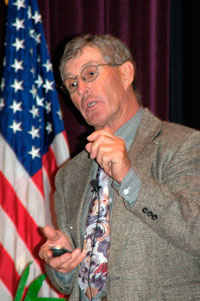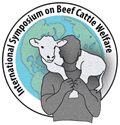Caregiver Responsibility:
Holistic Care of Beef Cattle
MANHATTAN, Kan. (May 20, 2010) — Veterinarian and stockmanship expert Tom Noffsinger emphasized the responsibility livestock caregivers have in ensuring animal well-being as he addressed participants of the International Symposium on Beef Cattle Welfare May 20. The second symposium was on the campus of Kansas State University.

Tom Noffsinger told symposium attendees thatlivestock caregivers should approach their interactions and handling of animals as if someone was following them with a video camera.
Livestock caregivers should approach their interactions and handling of animals as if someone was following them with a video camera, Noffsinger suggested. “This industry has a foundation in integrity and character and we need to build on that.”
To that end, continual education is essential to improving animal care and handling, he said. “The more we understand about animal interactions, the more we can move forward and be effective.”
Noffsinger provided several examples to help caregivers better understand cattle communication:
• Avoid human voice. “Cattle live where it’s quiet; they are not a verbally based species. So understanding this is a place to start," Noffsinger said.
• Think about body position. “Understand that your distance, angles, direction and the speed with which you respond to what an animal is doing impact how they will move,” Noffsinger pointed out. He added that there should be no need for a driving aid of any kind. Instead, by watching animals and learning how they will react, you should be able to move them using distance, angles, direction and speed.
• Understand a prey animal’s senses. “Prey animals like to be together, they are sensitive to motion and they need to feel like they can flee,” Noffsinger explained. He pointed out that prey animals crave being able to see everything. Thus, he said, “Always put yourself in a situation where animals can see you. Go to the front of animals, so they can see you, and they can see where you want them to go.” He said this starts with a baby calf. Don’t chase it. Teach it to come to you. “Approach it from the front, then you are teaching them,” Noffsinger said.
• Help prepare animals for the next step. This means getting animals acclimated to facilities, Noffsinger explained. “Some Saturday, run your heifers through your facility two or three times before you ever work them. It all takes preparation. When it’s time for cattle to be processed, it’s not a negative experience if they already know the facilities.”
Noffsinger noted in his remarks the importance of low-stress handling and animal care, saying, “People can impact carcass quality from conception to harvest."
As an industry we should elevate our expectations for animal care, and ownership and management must recognize that this initiative starts with them and then flows to all employees, Noffsinger said.
The beef cattle welfare symposium was conducted on campus at K-State University May 19-21. For additional presentation summaries, return to the Meetings > Other Industry Meetings > News Coverage page of the API Virtual Library. For more about the symposium and an archive to the 2008 symposium, visit www.isbcw.beefcattleinstitute.org.
Editor's Note: This article was written under contract or by staff of Angus Productions Inc. (API), which claims copyright to this article. It may not be published or distributed without the express permission of API. To request reprint permission and guidelines, contact Shauna Rose Hermel, editor, at 816-383-5270.

